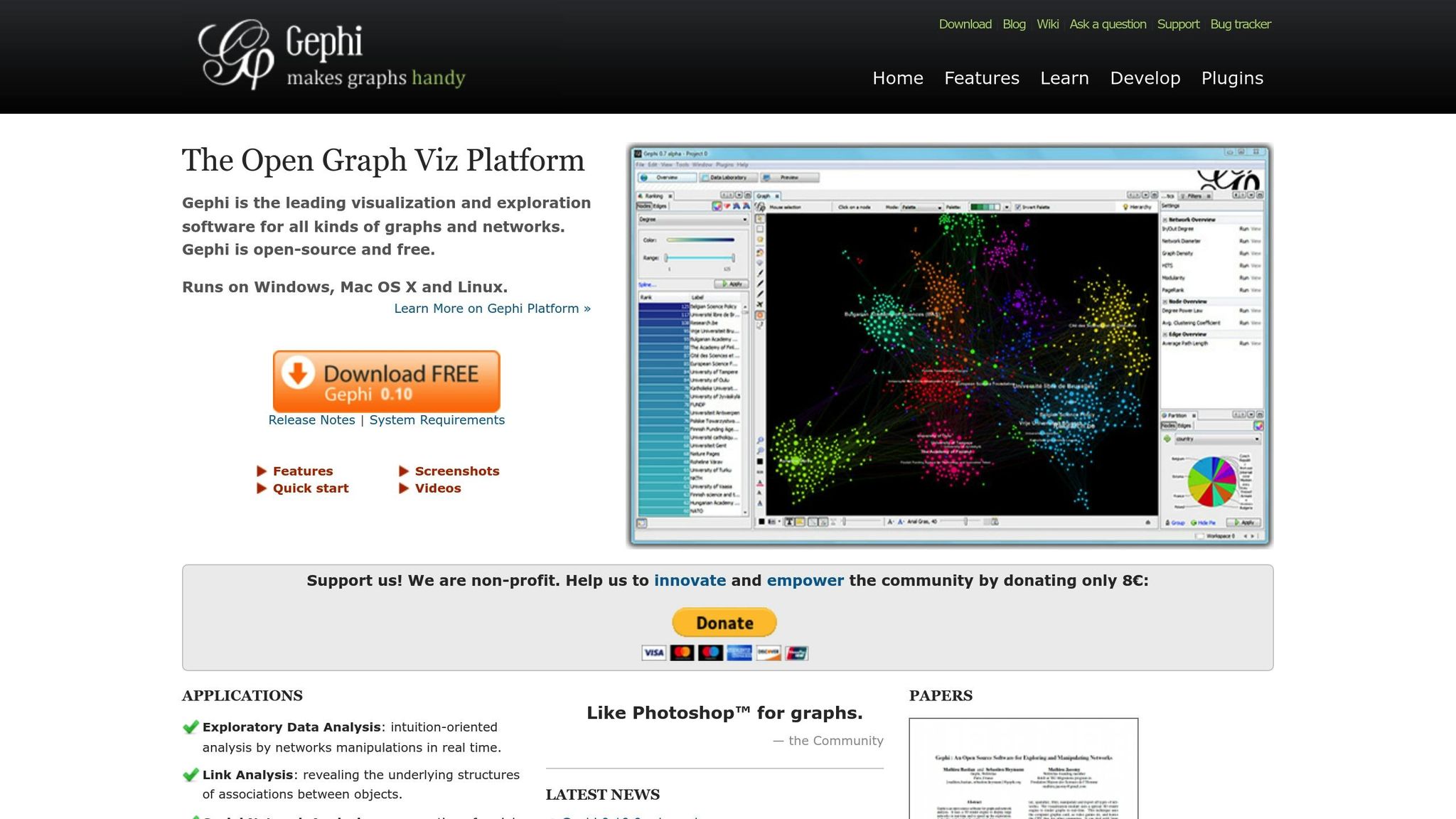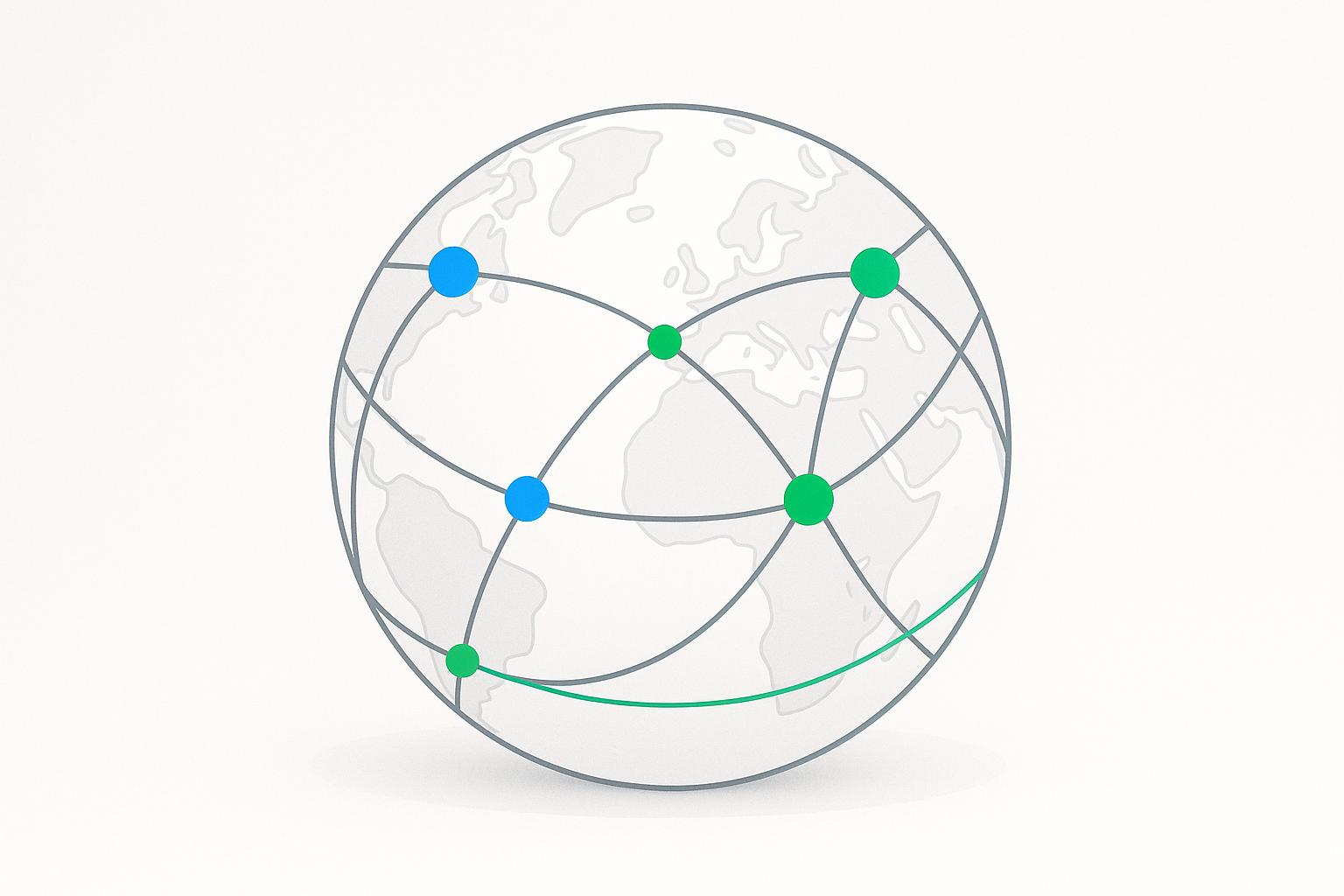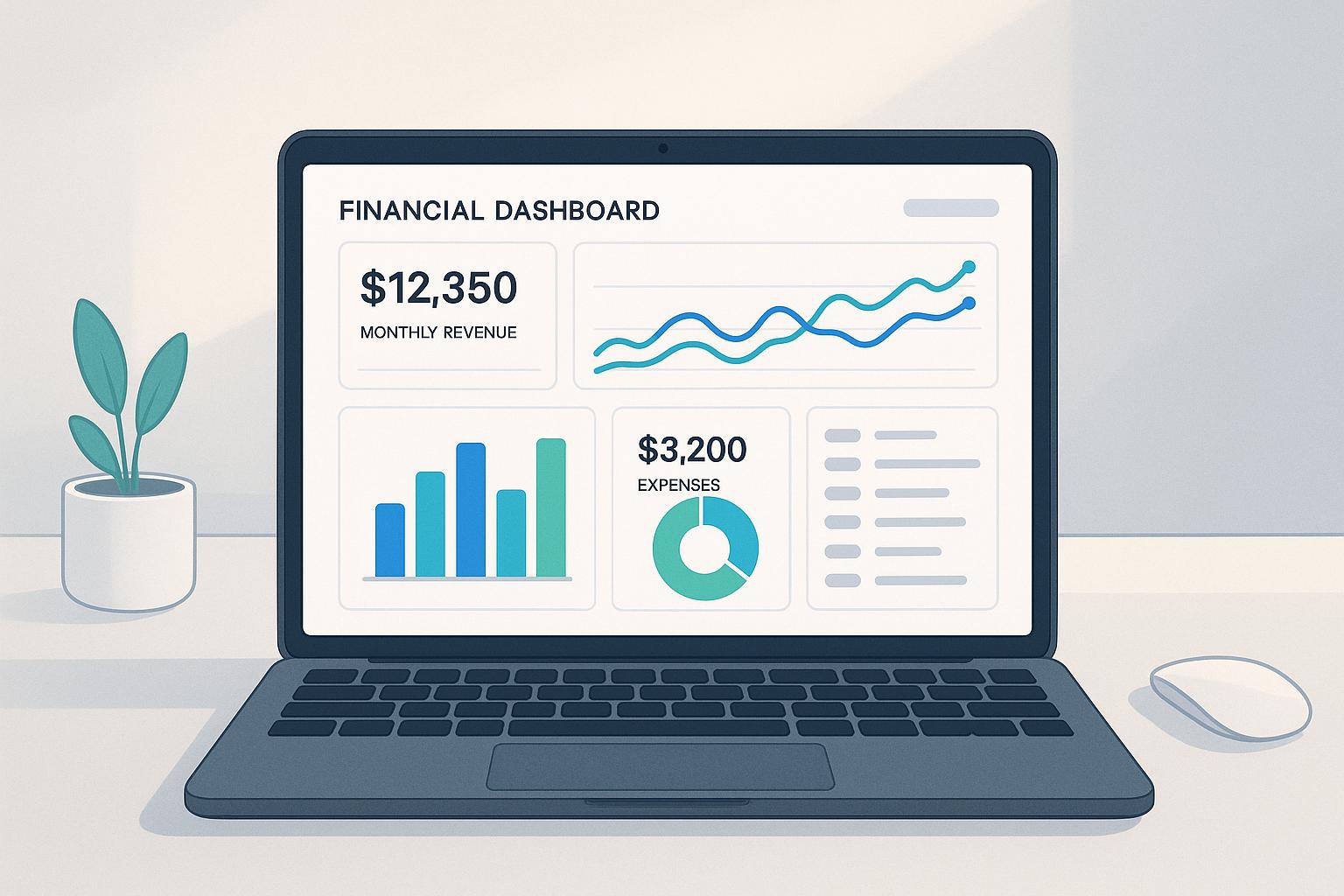Financial reporting is evolving - and blockchain is at the forefront of this transformation. By combining real-time data with dynamic visual tools like dashboards and graphs, businesses can now present financial information that's easier to understand and more transparent than ever. Here's what you need to know:
- Traditional systems rely on periodic reports, centralized databases, and manual processes. While reliable, they often result in delays, limited transparency, and static visuals that require constant updates.
- Blockchain-based systems offer real-time updates, secure data integrity, and transaction-level transparency. They also integrate seamlessly with modern visualization tools, making financial insights accessible and interactive for all stakeholders.
- Key advantages of blockchain include automated processes, unchangeable records, and the ability to tailor reports for different audiences. However, challenges like high setup costs and regulatory uncertainties remain.
For startups, especially those in fast-moving markets, blockchain's ability to provide instant insights can be a game-changer. While traditional methods remain valuable for compliance, a hybrid approach - combining both systems - can deliver the best of both worlds. Want to stay ahead? Focus on solutions that balance accuracy with speed, like blockchain-powered dashboards.
Visualise Blockchain Transactions in Gephi

1. Traditional Financial Reporting Methods
Traditional financial reporting relies on well-established accounting software and manual workflows to create periodic reports - typically on a monthly, quarterly, or annual basis. These reports provide a snapshot of financial performance at specific intervals. While this approach has been a cornerstone for businesses for decades, it does have some notable limitations when compared to more advanced, modern methods.
Transparency
In traditional reporting systems, data is often processed through centralized platforms, with multiple layers of human verification. While this may seem thorough, it increases the risk of errors and makes it harder to trace the origins of data. Additionally, most conventional accounting systems store information in proprietary formats, making it less accessible to external stakeholders. For auditors and investors, this means requesting specific reports and waiting for the necessary details to be shared. Even though compliance with standards like GAAP or IFRS ensures consistency, it doesn’t provide transaction-level clarity. This creates what’s often referred to as a "black box" effect - stakeholders see the final figures but have limited insight into the calculations or transactions behind them. The lack of immediate access to up-to-date data also delays critical decision-making.
Real-Time Insights
One of the biggest drawbacks of traditional methods is the reliance on batch processing and manual data extraction. Reports generated this way reflect past conditions rather than the current financial landscape. As a result, many businesses experience a lag between the end of a reporting period and the availability of comprehensive financial statements, leaving decision-makers to work with outdated information.
Data Integrity
Manual processes play a significant role in traditional financial systems, which can be both a strength and a weakness. While human oversight can catch some errors, it also introduces risks like data entry mistakes, calculation inaccuracies, and version control issues. These systems typically rely on centralized databases, which can become single points of failure. If a primary database is compromised, the entire financial history could be jeopardized. Moreover, manual reconciliation processes often allow discrepancies to go unnoticed for extended periods, delaying corrections and potentially impacting financial accuracy.
Visual Reporting Capabilities
Traditional accounting software generally includes basic visualization tools, such as pie charts, bar graphs, and line charts. However, these visuals are static and must be manually updated whenever the underlying data changes. This separation between data and visualizations makes it difficult to create cohesive, up-to-date visual reports. Additionally, combining information from multiple sources into a single, unified narrative is often cumbersome with these tools. This static approach leaves much to be desired, especially when compared to more dynamic solutions, such as blockchain-based systems, which aim to bridge these gaps with real-time updates and integrated visuals.
2. Blockchain Financial Reporting Methods
Blockchain technology is transforming financial reporting by introducing a decentralized ledger system that records every transaction across a network of computers. Unlike traditional methods that depend on centralized databases, blockchain operates on a distributed network where data is verified and stored across multiple nodes at the same time.
Transparency
Blockchain brings a new level of openness to financial reporting. Transactions are recorded on a public or permissioned ledger that can be accessed directly by stakeholders. Each entry is linked to the next through cryptographic hashes, creating an unalterable chain of data. This allows auditors, investors, and regulators to trace transactions back to their origins without needing additional documentation from the company.
Traditional systems often create a "black box" effect, where stakeholders must wait for periodic reports to understand financial activities. Blockchain eliminates this by offering real-time access to transaction-level details. Smart contracts further enhance this transparency by automating accounting processes like revenue recognition and expense categorization, ensuring consistency without requiring manual intervention.
Permissioned blockchain networks add another layer of control by allowing companies to regulate access. For instance, board members might have full access to all financial data, while investors see only aggregated summaries, and auditors are provided access to specific categories of transactions. This balance between transparency and controlled access supports accurate, real-time financial reporting.
Real-Time Insights
One of the standout features of blockchain is its ability to process transactions in real time. As soon as a payment is received or a financial event occurs, the transaction is verified by the network and added to the blockchain. This instantly updates related financial metrics and dashboards.
This real-time processing approach, often referred to as continuous accounting, ensures that financial data is always current. Cash flow statements, profit and loss summaries, and balance sheets update automatically as new transactions are confirmed. Decision-makers no longer have to rely on outdated reports or wait for month-end closings to get a clear picture of the company’s financial health.
These instantaneous updates also enable proactive decision-making. With up-to-date financial data at their fingertips, leaders can address issues and seize opportunities as they arise, rather than reacting to problems after the fact.
Data Integrity
Blockchain’s cryptographic structure ensures data remains secure and tamper-proof. Each transaction block is assigned a unique hash, and any attempt to alter the data within a block changes the hash, alerting the network to potential tampering. This creates a secure, unchangeable audit trail.
Transactions are validated through a consensus mechanism, which requires multiple network participants to approve each entry before it is added to the blockchain. This distributed verification process eliminates single points of failure and significantly reduces the risk of fraudulent entries. If one node attempts to introduce an invalid transaction, it will be rejected by the others, preserving the integrity of the financial records.
Immutable timestamps further enhance security by ensuring that all financial events are recorded in chronological order. This prevents issues like duplicate entries, unauthorized adjustments, or attempts to manipulate the books, which are common risks in traditional accounting systems.
Visual Reporting Capabilities
Blockchain data integrates seamlessly with modern visualization tools, providing interactive dashboards that update continuously. Unlike static reports generated from traditional systems, these visualizations reflect real-time financial conditions without requiring manual updates.
Smart contracts play a key role in automating data categorization and feeding information into tailored visualization templates. This allows companies to generate dynamic charts and graphs that adjust to the needs of different stakeholders. For instance, revenue streams, expense breakdowns, and cash flow patterns can be displayed in real-time, offering an immediate understanding of financial trends.
Blockchain-powered systems also support multi-dimensional analysis. Users can dive deep into financial summaries to explore individual transaction details, uncovering patterns and trends that might go unnoticed in static reports. For example, companies can visualize geographic revenue distribution, analyze time-based spending patterns, or assess vendor relationships, all from the same dataset.
The programmable nature of blockchain allows for customized reporting frameworks. Whether it’s an investor presentation, a regulatory filing, or an internal management report, all these outputs can be drawn from the same blockchain data while being tailored to meet the specific needs of each audience. This flexibility ensures that stakeholders receive the insights they need in a format that’s easy to understand and act upon.
sbb-itb-17e8ec9
Advantages and Disadvantages
When deciding how to present financial data visually, both traditional methods and blockchain-based reporting come with their own set of strengths and challenges.
Traditional financial reporting benefits from decades of refinement, with regulatory frameworks like those from the SEC and FASB offering clear guidelines. This established infrastructure ensures reliability and consistency.
On the flip side, traditional methods often suffer from delays. Reporting cycles can take weeks or even months, leaving stakeholders working with outdated data. Manual processes also introduce the risk of human error, and creating visual reports often requires additional tools and manual data exports. As a result, maintaining real-time dashboards can be a logistical headache.
Blockchain financial reporting, on the other hand, offers real-time updates and an immutable audit trail, which can boost trust among stakeholders. Features like transparency and automation through smart contracts make it appealing. However, blockchain comes with its own hurdles: its technical complexity, evolving regulatory landscape, and potential resistance from stakeholders who prefer the controlled information flow of traditional systems.
Here’s a quick comparison of key criteria for both approaches:
| Criteria | Traditional Methods | Blockchain Methods |
|---|---|---|
| Transparency | Limited to periodic reports; controlled information flow | Real-time access to transaction-level data; programmable access controls |
| Real-Time Insights | Monthly or quarterly cycles; manual updates required | Instant updates with continuous accounting; automated processes |
| Data Integrity | Vulnerable to errors; relies on manual verification | Cryptographic security; distributed validation; immutable records |
| Visual Reporting | Static reports; requires manual updates and external tools | Dynamic dashboards with integrated, real-time updates |
| Implementation Cost | Lower initial setup; uses existing infrastructure | Higher upfront costs; technical complexity in setup |
| Regulatory Compliance | Well-established standards and guidelines | Evolving regulations; uncertain compliance requirements |
| Staff Training | Familiar processes; minimal learning curve | Requires technical expertise; blockchain-specific training |
The choice between these methods depends on a company’s priorities. For firms that need real-time insights, blockchain might be the better fit. On the other hand, companies dealing with strict regulatory requirements may find traditional systems more practical.
For startups and rapidly growing businesses, this decision becomes even more critical. Blockchain’s scalability and automation can handle increasing transaction volumes with ease, while traditional methods may require more manual intervention as operations expand.
A hybrid approach is becoming an attractive option. Many companies are keeping traditional systems for compliance while incorporating blockchain for specific use cases, such as supply chain finance or investor reporting. This allows businesses to reap the benefits of blockchain’s real-time transparency while minimizing risks tied to implementation and regulation.
Platforms like Lucid Financials highlight the potential of combining these two approaches. By integrating blockchain’s transparency with the reliability of traditional accounting, companies can create agile, investor-ready dashboards that support smarter, more dynamic financial reporting.
Conclusion
Blockchain visual storytelling is reshaping financial reporting in ways that traditional methods simply can't match. With real-time transparency, unchangeable data records, and automated reporting, blockchain technology is changing how startups and rapidly growing companies connect with investors and make informed decisions.
One of blockchain's standout advantages is its ability to provide instant insights, rather than relying on periodic updates. This is especially crucial for startups navigating dynamic, fast-moving markets where financial conditions can shift quickly. For these businesses, blockchain offers a fresh approach to financial communication that aligns with the pace of modern industries.
For startups, adopting blockchain - whether fully or as part of a hybrid approach - can unlock scalable, investor-friendly reporting. Its ability to handle growing transaction volumes without increasing manual effort is a game-changer. Plus, real-time, transparent financial data can streamline fundraising by fostering trust and speeding up due diligence.
However, implementing blockchain should be strategic. Companies should begin by identifying areas where blockchain offers the most value, such as investor reporting or supply chain finance. At the same time, keeping traditional systems in place for regulatory compliance is a smart move until blockchain regulations become more established.
The best financial reporting solutions combine the dependability of traditional methods with the innovation of blockchain. Tools like Lucid Financials exemplify this balance, offering AI-powered financial management that delivers real-time insights and investor-ready reporting while upholding accuracy and compliance. For founders, this mix of transparency and automation lays the groundwork for smarter financial storytelling and sharper decision-making.
FAQs
How does blockchain make financial reporting more transparent and accurate than traditional methods?
Blockchain technology enhances financial reporting by delivering real-time updates and ensuring accurate data through its decentralized, consensus-based system. This approach eliminates inconsistencies and ensures that information remains current and reliable.
Moreover, blockchain establishes an unchangeable audit trail for each transaction, significantly lowering the chances of errors or fraud. This strengthens trust and accountability in financial reports, making them more transparent and trustworthy for stakeholders.
What challenges and costs should businesses consider when using blockchain for financial reporting?
Implementing blockchain in financial reporting is no walk in the park - it demands meticulous planning and a clear strategy. Some of the main hurdles include scalability issues, data privacy concerns, and high energy consumption, all of which might require substantial technical upgrades and adjustments to meet compliance standards. On top of that, keeping up with the ever-changing regulatory environment can be a tough challenge for businesses.
The financial commitment primarily revolves around initial investments in building the right technology infrastructure, training employees, and ensuring regulatory compliance. That said, these upfront costs can lead to significant long-term advantages. By tapping into automation, organizations can cut down on operational and audit costs, while also boosting data accuracy. Though the initial price tag might seem steep, the promise of greater efficiency and transparency often makes blockchain a smart bet for companies looking to stay ahead of the curve.
How can startups combine traditional financial reporting with blockchain technology to improve their operations?
Startups have the opportunity to combine blockchain technology with traditional financial reporting methods to improve data security, transparency, and trust. Thanks to blockchain's tamper-resistant design, financial data can be shared in real time, cutting down on fraud risks and simplifying audit processes.
Another advantage of this approach is the ability to implement customizable access controls, giving startups the flexibility to maintain privacy while still being transparent. On top of that, blockchain can help reduce transaction costs, speed up settlement times, and simplify financial workflows - making it a smart choice for rapidly growing businesses looking to scale efficiently.

